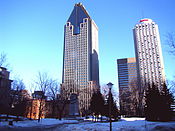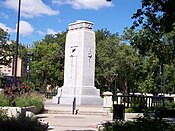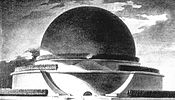
The Cenotaph, Whitehall, London
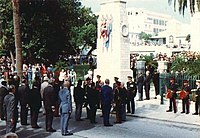
Remembrance Day parade, at the Cenotaph, in the City of Hamilton, Bermuda.

The Cenotaph, Auckland, New Zealand
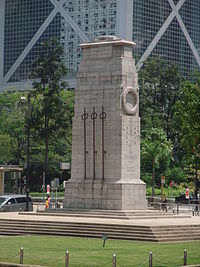
The Cenotaph, Hong Kong

National War Memorial, Canada

JFK Memorial, Dallas

Voortrekker Monument, South Africa

Hobart Cenotaph, Tasmania, Australia - with wreaths for ANZAC Day
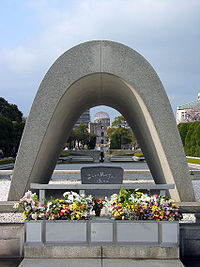
Memorial Cenotaph, Hiroshima, Japan
A cenotaph is an "empty tomb" or a monument erected in honour of a person or group of people whose remains are elsewhere. It can also be the initial tomb for a person who has since been interred elsewhere. The word derives from the Greek: κενοτάφιον = kenotaphion (kenos, one meaning being "empty", and taphos, "tomb"). Although the vast majority of cenotaphs are erected in honour of individuals, many noted cenotaphs are instead dedicated to the memories of groups of individuals, such as the lost soldiers of one country or empire.
History[]
Cenotaphs were common in the ancient world with many built in Ancient Egypt, Ancient Greece and across Northern Europe (in the shape of Neolithic barrows). Sir Edwin Lutyens' cenotaph in London influenced the design of many other war memorials in Britain and the British sectors of the Western Front, as well as those in other Commonwealth nations.
The Church of Santa Engrácia, in Lisbon, Portugal, turned into a National Pantheon since 1966, holds six cenotaphs, namely to Luís de Camões, Pedro Álvares Cabral, Afonso de Albuquerque, Nuno Álvares Pereira, Vasco da Gama and Henry the Navigator.
The Basilica di Santa Croce in Florence, Italy, contains a number of cenotaphs including one for Dante Alighieri,who is buried in Ravenna.
Regional[]
Asia[]
Among Asian countries, the Cenotaph in Central of Hong Kong Island, Hong Kong, the Cenotaph in Kuala Lumpur, the Cenotaph in Singapore and the Cenotaph in Colombo were erected as memorials to the war dead of World War I. The concrete Memorial Cenotaph at the Hiroshima Peace Memorial Park was designed by Kenzo Tange to commemorate the 200,000 victims of the August 1945 atomic bomb attack.
A cenotaph was erected inside the Manila North Cemetery in the Philippines in honor of the 24 Scouts who died in a plane crash en route to the 11th World Scout Jamboree.
Australia[]
In Australia, Anzac Day commemorations are usually held at all of the nation's many war memorials, but not all of them are cenotaphs. The Sydney Cenotaph is in Martin Place and the Hobart Cenotaph is in the Queens Domain.
Bermuda[]
A limestone replica of the Cenotaph at Whitehall in London was erected outside the Cabinet Building in Hamilton, Bermuda in 1920.[1]
Canada[]
In Canada, major cenotaphs commemorating the nation's war dead in World War I and later conflicts include the National War Memorial (a cenotaph surmounted by a bronze sculpture entitled "The Response") in Ottawa; Montreal, Toronto, Hamilton, Victoria, St. John's and the Victory Square Cenotaph, in Vancouver, British Columbia.
South Africa[]
A cenotaph is the focal point of the Voortrekker Monument in Pretoria, South Africa. It is situated below the other main point of interest, a marble Historical Frieze in the Hall of Heroes, and is visible through a round opening in the floor. The Hall of Heroes itself has a dome from the summit of which one can view the interior of the monument. At noon on 16 December each year the sun shines through another opening in the dome onto the middle of the cenotaph, where the words Ons vir Jou, Suid-Afrika (from Die Stem van Suid-Afrika; Afrikaans for "We for Thee, South Africa") are inscribed. The ray of sunshine symbolises God's blessing on the lives and endeavours of the Voortrekkers. 16 December is the date in 1838 that the Battle of Blood River was fought.
Durban, South Africa, has a striking and unusual cenotaph made of granite and lavishly decorated with brightly coloured ceramics.
United Kingdom[]
London[]
A cenotaph in the UK that stands in Whitehall, London, was designed by Sir Edwin Lutyens[2] and replaced Lutyens' identical wood-and-plaster cenotaph erected in 1919 for the Allied Victory Parade, and is a Grade I listed building.[3] It is undecorated save for a carved wreath on each end and the words "The Glorious Dead," chosen by Lloyd George. It was intended to commemorate specifically the victims of the First World War, but is used to commemorate all of the dead in all wars in which British servicemen and women have fought. The dates of the First World War and the Second World War are inscribed on it in Roman numerals. The design was used in the construction of many other war memorials throughout the British Empire.
Belfast[]
The Cenotaph in Belfast, Northern Ireland, is located in the grounds of Belfast City Hall and is set within a Garden of Remembrance. It is about 9.5 metres (31 ft) high and presents several carvings including laurel wreaths, symbolising victory and honour. The Cenotaph is the site of the annual Northern Ireland memorial held on Remembrance Sunday, the closest Sunday to 11 November (Armistice Day).
United States[]
In the United States, a cenotaph in Yale University's Hewitt Quad (or Beinecke Plaza) honours men of Yale who died in battle. The John Fitzgerald Kennedy Memorial in Dallas is often described as a cenotaph.
The Battle Monument in Battle Monument Square in Baltimore, Maryland, commemorates the Battle of Baltimore, with the Battle of North Point on September 12, 1814, and the following Bombardment of Fort McHenry on September 13-14th, (which resulted in Francis Scott Key, (1779-1843), writing the poem "The Defence of Ft. McHenry", which later set to music a few days later as the "Star-Spangled Banner", eventually in 1931 became the National Anthem) and the fortifications and stand-off on "Loudenschlager's Hill (now "Hampstead Hill" in Patterson Park) and honors those who died during that month of September 1814, during the War of 1812. It has an Egyptian Revival cenotaph base, surmounted by a fasces bound together with ribbons bearing the names of the dead, designed by French émigré architect J. Maximilian M. Godefroy in 1815, which was constructed to 1827. It is considered the first and oldest war memorial in America, especially to remember the individual soldiers fallen. The Monument appears on the Seal and the logo of the City of Baltimore and serves as a symbol for any agencies of the municipal government.[4]
A cenotaph for the defenders of the Battle of the Alamo of March 1836, stands in front of the Alamo mission chapel in San Antonio, Texas. The cenotaph was placed because the bodies of the Texans were burned following the battle.
At Virginia Polytechnic Institute, situated atop War Memorial Chapel, there is a cenotaph honoring all Virginia Tech cadets who have been killed in battle. Inscribed upon the cenotaph are the names of the seven Virginia Tech Alumni who have been awarded the Medal of Honor.
Zambia[]
In Livingstone there is a cenotaph at the Eastern Cataract of The Victoria Falls with the names of the men of Northern Rhodesia who died during the Great War 1914–18. It was unveiled by HRH Prince Arthur of Connaught on 1 August 1923.
Cenotaphs for the missing[]
Although most notable cenotaphs commemorate notable individuals buried elsewhere, many cenotaphs pay tribute to people whose remains have never been located. Two such cenotaphs are dedicated to victims of the RMS Titanic, whose bodies were not recovered after the sinking. The cenotaph of Ida Straus[5] serves as the gravestone for her husband Isidor Straus at Woodlawn Cemetery in the Bronx, and the striking cenotaph of Major Archibald Butt, aide to U.S. President William Taft, is located at Arlington National Cemetery.[6]
Chhatris[]
In India, cenotaphs are a basic element of Hindu architecture, later used by Moghuls as seen in most of the mausoleums of Mughal Emperors which have two burial chambers, the upper one with a cenotaph, as in Humayun's Tomb, Delhi, or the Taj Mahal, Agra, while the real tomb often lies exactly below it, or further removed. The Chahatri(s) trace their origin at 2000 years ago at Fort Kangara. The term chhatri, used for these canopylike structures, comes from Hindustani word literally meaning umbrella, and are found throughout the northwestern region of Rajasthan as well as in Madhya Pradesh and Maharashtra. In the Shekhawati region of Rajasthan, chhatris are built on the cremation sites of wealthy or distinguished individuals. Chhatris in Shekhawati may consist of a simple structure of one dome raised by four pillars to a building containing many domes and a basement with several rooms. In some places, the interior of the chhatri is painted in the same manner as the Haveli.
Art[]
Cenotaphs have also been the subject of a number of illustrations including:
- The Cenotaph to Reynold's Memory (John Constable, c. 1833)
- Elevation for Newton's Cenotaph, Perspective (Etienne-Louis Boullée, c. 1785)
- The Cenotaph of Jean Jacques Rousseau (Hubert Robert, 1794)
Digital[]
In the Internet age, virtual cenotaphs are common in the game World of Warcraft.[7][8][8] They have also been created in the augmented reality game Ingress in honor of the slain MIT police officer Sean Collier[9] and in memory of the victims of the 1942 Struma disaster.[10]
Gallery[]
See also[]
- Grave (burial)
- Shrine of Remembrance in Melbourne, Victoria, Australia
- Tomb of the Unknown Soldier
- War memorial
References[]
- ↑ http://www.bermuda-attractions.com/bermuda2_000085.htm
- ↑ Skelton & Gliddon – Lutyens and the Great War, published 2008, Pages 23–47 (also see external link below: Cenotaph of Sigismunda and Lutyen's Whitehall Cenotaph)
- ↑ "Buildings of outstanding or national architectural or historic interest."
- ↑ Dorsey, John & Dilts, James D., "Guide to Baltimore Architecture" (1997) p. 145–146. Tidewater Publishers, Centreville, Maryland ISBN 0-87033-477-8
- ↑ Find A Grave. "Ida Straus". http://www.findagrave.com/cgi-bin/fg.cgi?page=gr&GRid=3677. Retrieved 11 July 2010.
- ↑ "Titanic Memorials: Archibald Butt Cenotaph, Arlington National Cemetery – Arlington, VA". http://www.glts.org/memorials/dc/arlington.html. Retrieved 11 July 2010.
- ↑ http://gamestudies.org/1201/articles/gibbs_martin
- ↑ 8.0 8.1 https://www.youtube.com/watch?feature=player_embedded&v=iK44XQIzLos#t=128
- ↑ Scott Kirsner (April 24, 2013). "In Google's Ingress augmented reality game, a ceasefire at MIT and a memorial to slain officer Sean Collier". Boston Globe. http://www.boston.com/business/technology/innoeco/2013/04/in_googles_ingress_augmented_r.html. Retrieved June 2, 2013.
- ↑ https://sites.google.com/site/operationstruma/
Further reading[]
External links[]
| Wikimedia Commons has media related to Cenotaph. |
| Wikimedia Commons has media related to Cenotaphs. |
- The New London School explosion cenotaph Memorial
- Cenotaph of Sigismunda and Lutyen's Whitehall Cenotaph
The original article can be found at Cenotaph and the edit history here.






